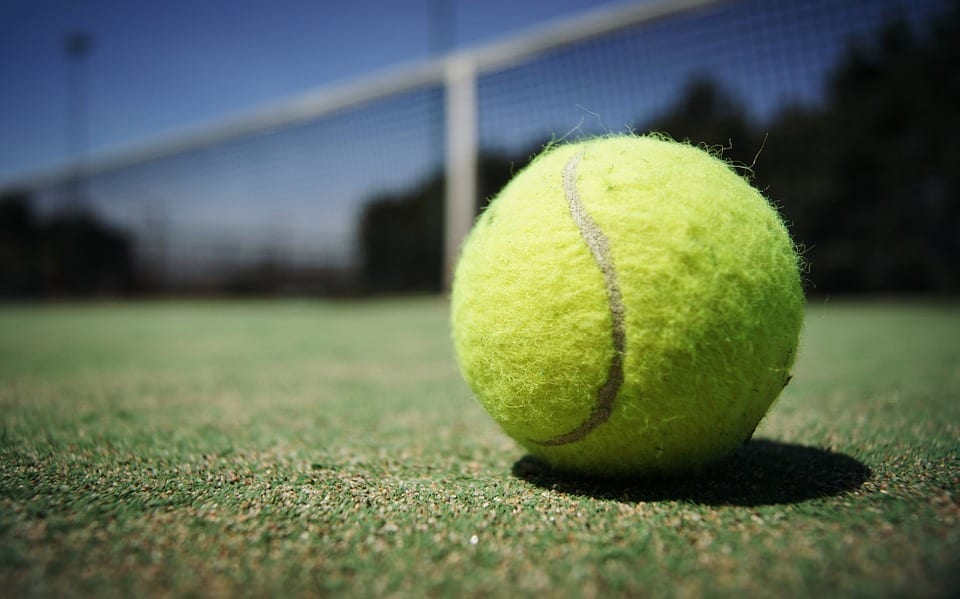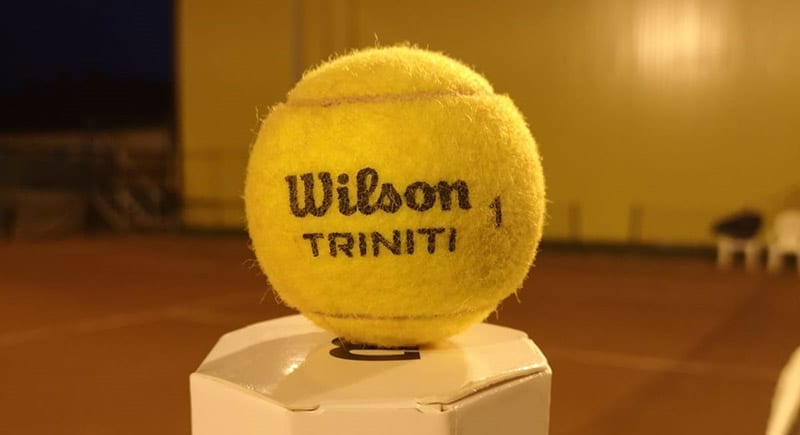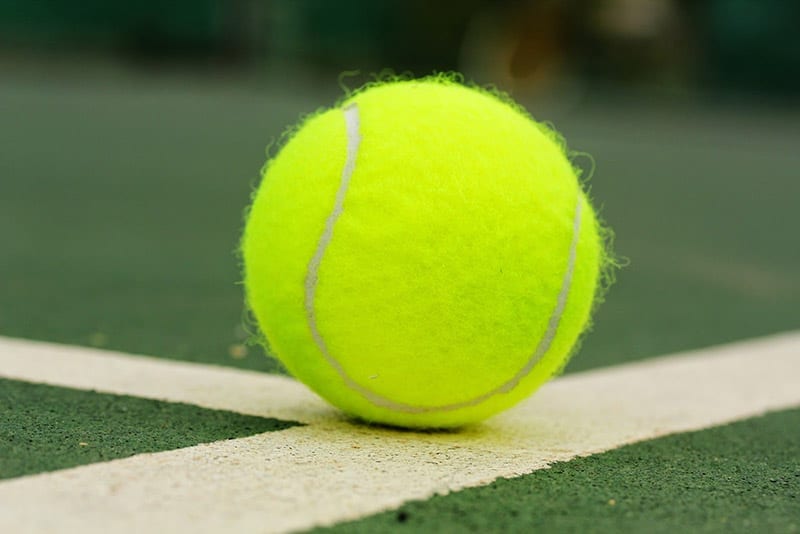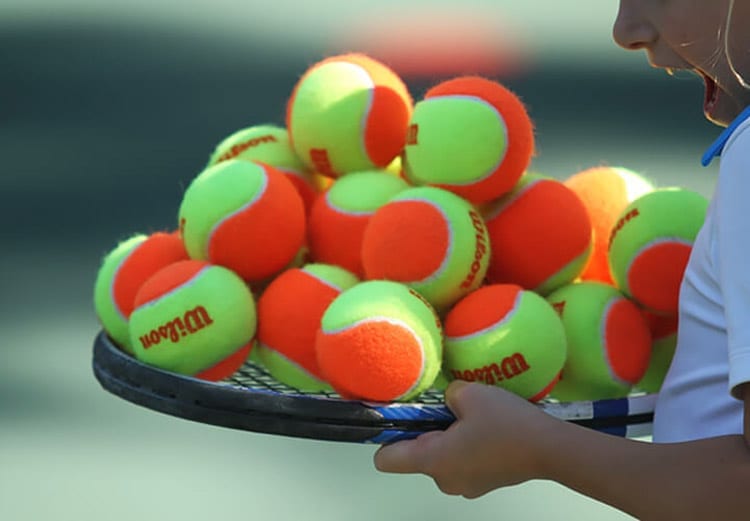A tennis ball is a tennis ball, right? Actually there are many tennis ball types.
People just think, “Oh, those things that go on the bottom of my grandmother’s walker,” but they’re not quite so one-dimensional.
With different felt options, pressurization and overall altitude adjustments, you have to make a distinct choice on what type of tennis ball you’re going to use for practice and matches.
For a very basic description, tennis balls are round, and made from rubber wrapped in a fuzzy, typically yellow, felt material.
They either have a solid core (pressureless) or a hollow core filled with some sort of gas (pressurized).
The felt is ether standard (regular duty) or quite thick (heavy duty). Let’s break down their differences.
Contents
Pressurized
Pressurized tennis balls have either air or gas (likely nitrogen) on the inside of the rubber core and are used on the pro circuit.
Most recreational tennis players also use pressurized tennis balls as they tend to result in a better playing experience.
When first opened, a pressurized ball will have a distinct smell (it’s a tennis thing!) and will have a very lively bounce.
With a hollow core, pressurized balls weigh less and can travel faster across the net.
Unfortunately they start to degrade as soon as the can is opened.
In professional matches, they’re switched out every 9 games to keep a consistent ball in play.
Most recreational players don’t have the luxury of using new balls as often as that. Usually they last for an entire match, or if just practice sessions, two to three weeks.
Pressureless
Pressureless tennis balls don’t have any form of gas on the inside like pressurized tennis balls do.
Instead, they have a solid rubber ball core.
They’re easy to manufacture, and can be used for practice sessions where working on stroke mechanics tends to be the goal.
If you wanted to fill a tennis ball machine, you would likely do so with pressureless balls. Its more cost-effective and the balls have a longer lifespan.
Regular Duty

Regular duty tennis balls are a standard tennis ball – no frills or extra felt.
You might see these listed as normal or standard, but when you’re getting technical, they’re called regular duty.
These come pressurized and are equipped for official tennis use.
A regular duty tennis ball will wear down faster than other varieties of tennis balls (heavy duty, high altitude).
They’re designed to be used on softer courts – namely clay.
The felt layer on the outside isn’t as fuzzy (thinner) so as not to pick up clay when in use.
Heavy/Extra Duty

The main difference between regular duty balls and extra duty balls is the felt layer on the outside.
Heavy duty balls tend to be used on hard and grass courts.
The heavier layer of felt provides extra durability when lends them to harder courts.
High Altitude

Appropriately named, high altitude tennis balls are designed to be used in spots above 4,000 feet above sea level where the air starts to thin out.
These balls are approximately 6% larger in diameter than non high altitude tennis balls.
The air pressure at higher altitudes is reduced which results in balls flying through the air at faster speeds.
Using a larger tennis ball helps to slow down the speed some and mimic more of what’s found at lower altitudes.
High altitude tennis balls are priced similarly to standard or heavy duty tennis balls. They are also packaged in pressurized canisters like regular or heavy duty tennis balls.
Are All Tennis Balls the Same?
Nope. As you can see, there’s definite variety in the tennis ball types available for use.
You don’t have extensive types to choose from, but they’re made differently to account for multiple circumstances of play.
In addition to choosing the right ball for court surface, you can mix things up with colors as well.
The majority of tennis balls on the market are yellow, but Wilson is known for having different ball color options.
This can be beneficial to colorblind users, but is also a nice way to inject some expression into your game!
There are only so many different ways that a tennis ball is made, so once you find what works for you, you’ll be good to go.
Difference Between Practice Tennis Balls and Standard Ones
There’s usually no difference between the rubber core, the felt, and the designs, the only thing that matters is the pressurization.
Practice balls are made the way they are for a reason, and that’s because unpressurized tennis balls are far cheaper than pressurized ones.
On average, you can get three to four unpressurized balls for the price of a single pressurized one.
When you go to fill up a tennis ball machine with its 150 ball capacity, you probably don’t want to use your brand new match-ready balls.
Unpressurized balls allow you to fill up your hopper for a fraction of the cost.
The other main difference is longevity.
Practice tennis balls are going to last a lot longer than pressurized tennis balls, solely for the reason that they aren’t slowly losing trace amounts of a specific material that impacts their durability and usage.
What About Junior Tennis Balls?
Junior tennis balls are made smaller and with different gas contents in the pressurized versions to align with junior level players.
If you had a child who was about four feet tall, are you going to put them up against the same equipment and expectations of a six-foot-tall guy who’s used to playing against other adult players?
No, you’re going to scale the equipment down to their size, just like you do with junior tennis rackets.
Junior tennis balls usually just come in regular duty pressurized and regular duty unpressurized versions, because that’s all you really need.
Your Equipment Matters
Are you more familiar with the tennis ball types available? Based on varying playing situations, different types of tennis balls are recommended for the most pleasant playing experience.
Ideally you’d use a different ball type for grass courts at altitude compared to clay courts at sea level or a practice session with a ball machine indoors at your local tennis club.
Keep in mind that you only have so much life per tennis ball. Make sure to keep ample stock for how often you play.
Experiment with different brands to find your preference.




